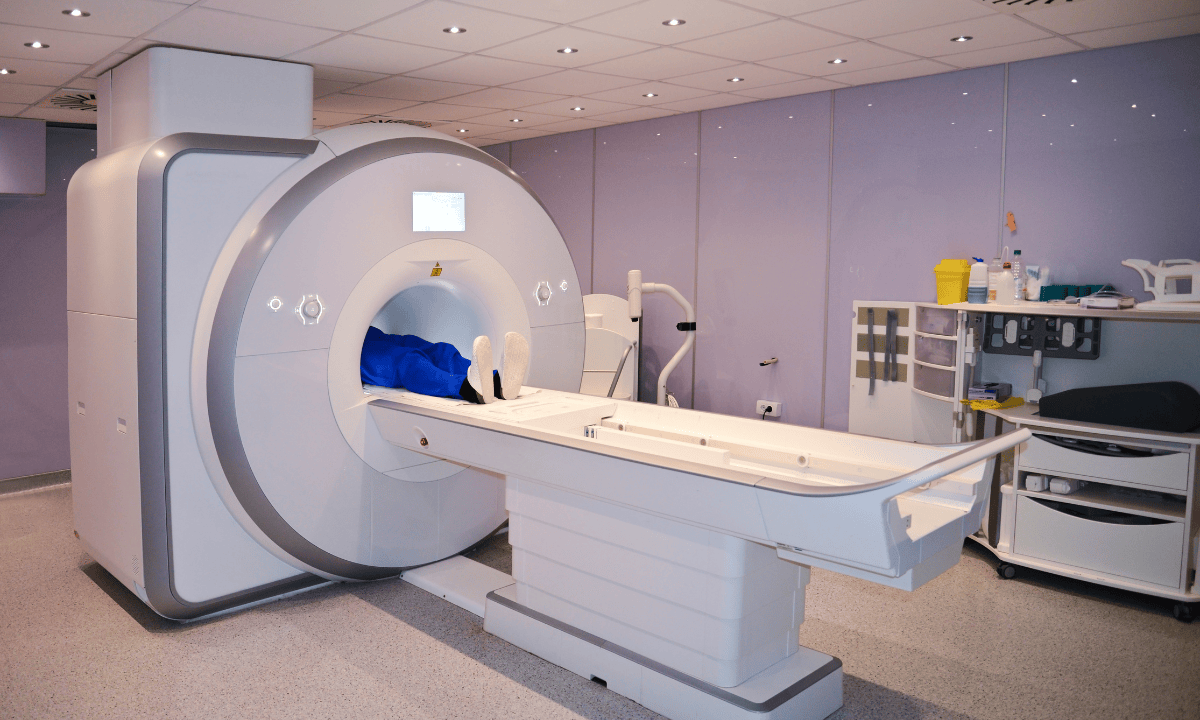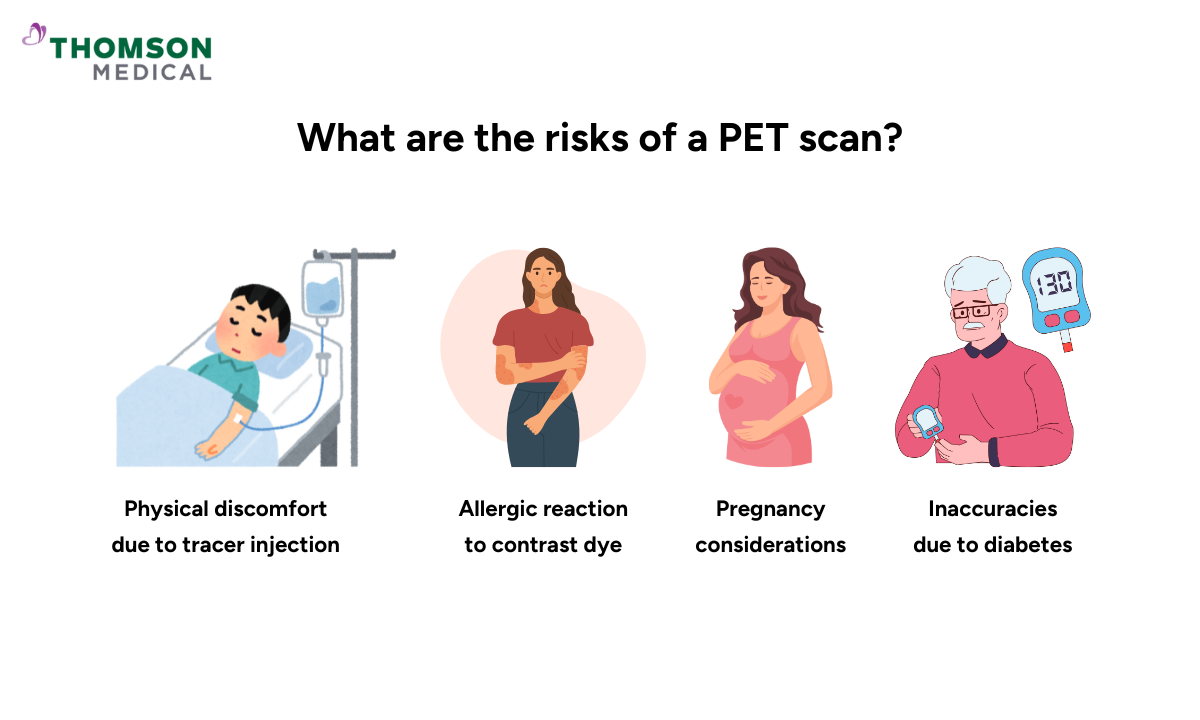What is a Positron Emission Tomography (PET) scan?
A Positron Emission Tomography (PET) scan is a medical imaging test that produces a detailed picture of the metabolic activity of your organs and tissues. The test uses a safe, radioactive tracer to highlight areas of abnormal metabolic activity, which can help detect a variety of conditions, including cancer, heart disease, and brain disorders.
In Singapore, PET scans are available in both public and private hospitals. Although it involves minimal radiation exposure, it's an effective and safe imaging test for early detection of disease, allowing your healthcare provider to make treatment plans as early as possible.
What is the difference between a PET scan, CT scan, and MRI?
PET scans, Computed Tomography (CT) scans, and Magnetic Resonance Imaging (MRI) are all types of medical imaging. However, they differ in the way they work and the technology they use; here are their differences:

PET scan
This imaging test uses a small amount of a radioactive sugar-based fluid called a tracer. This radioactive tracer emits energy that the scanner detects, allowing the doctor to watch metabolic activity in your organs and tissues in real time.
PET scans are particularly useful for detecting abnormalities in organ function, such as cancer or brain disorders.
CT scan
A CT scan uses a rotating beam of X-rays to produce detailed cross-sectional images of the body's internal structures, such as bones, organs and blood vessels. CT scans are quick and widely available, making them ideal for emergency situations.
MRI
An MRI machine uses a powerful magnet and radio waves to produce detailed images of soft tissues such as the brain and spinal cord. Unlike CT or PET scans, MRI does not use radiation, making it ideal for diagnosing neurological or musculoskeletal conditions.
Although these are separate medical imaging techniques, a PET scan can be combined with CT scans (PET-CT) or MRI scans (PET-MRI) to increase accuracy and provide more comprehensive diagnostic information.
PET-CT scans
PET-CT scans combine metabolic data from a PET scan with anatomical detail from a CT scan. The result is a 3D image that helps doctors more accurately locate and assess abnormalities, particularly in cancer staging and diagnosis.
PET-MRI scans
PET-MRI is a newer technology that combines PET with MRI to produce high-contrast images of soft tissue. This combination is particularly useful for diagnosing and monitoring cancers in areas such as the brain, head, neck, liver, and pelvis.
This hybrid imaging test provides high-resolution images with minimal radiation exposure.
Not sure which type of imaging test suits your condition? Request an appointment with Thomson Medical to consult a healthcare provider who can help determine which medical imaging method best suits your medical condition.
When is a PET scan necessary?

A PET scan may be recommended by your healthcare provider for various medical conditions, including:
Cancer conditions
Detecting cancerous tumours and determining their activity.
Assessing whether cancer has spread (metastasised).
Monitoring the effectiveness of cancer treatments.
Detecting signs of cancer recurrence.
Neurological disorders
Diagnosing brain disorders such as Alzheimer's disease, epilepsy, Parkinson's disease, Huntington's disease and stroke.
Locate areas of abnormal brain activity, such as those causing seizures or tumours.
Heart disease
Assessing areas of reduced blood flow in the heart.
Assessing the effects of a heart attack on areas of the heart.
Identifying areas of the heart muscle that may benefit from procedures such as angioplasty or coronary artery bypass surgery.
Help decide treatment strategies for clogged arteries or other heart problems.
In addition, this imaging test can be used to identify areas of abnormal metabolic activity caused by infection or inflammatory disease. PET scans are particularly useful because they can detect cellular changes before structural abnormalities appear on imaging techniques such as CT or MRI scans.
How does a PET scan work?
Before the PET scan begins, your healthcare provider will inject a small amount of a radioactive tracer, usually a fluorodeoxyglucose (FDG), into your arm vein. This tracer travels through your bloodstream and accumulates in areas of increased metabolic activity, such as cancer cells or active brain regions.
That's because cancer cells grow rapidly, so they use more energy and therefore more sugar than normal cells. This increased sugar uptake causes them to appear as bright “hot spots” on the scan, while areas of low tracer uptake may indicate reduced blood flow or abnormal function.
During the imaging scan, the PET scanner then detects the radiation emitted by the tracer and produces detailed images that show how your tissues and organs are functioning in real time. Although the scanner looks like a CT or MRI machine, it doesn't have any X-rays or magnets inside it.
How do I prepare for a PET scan?
Before your PET scan, your healthcare provider will give you specific instructions to help you prepare. This imaging test is usually performed by a radiologist and usually takes 30 to 60 minutes. The PET scan is an outpatient procedure, which means you can go home the same day.
Here are some general guidelines to help you prepare:
Fasting
You'll probably be asked not to eat for 4 to 6 hours before the scan. You can drink water, but avoid other drinks, especially if they contain caffeine.
Clothing
Before the scan, you may be asked to change into a hospital gown and remove jewellery, glasses, or other metallic objects.
Activity
Avoid strenuous exercise for at least 24 hours before the scan.
Medications
If you have diabetes, tell your doctor about all your medications, as you may need to adjust your diabetes medicine dose.
Medical conditions
Tell your healthcare provider if you have any allergies or underlying medical conditions, or if you're pregnant.
Claustrophobia or anxiety
If you are anxious about being in enclosed spaces, talk to your healthcare provider. You may be given anaesthesia to help you relax during the scan.
About an hour before the scan, you'll be given an injection of a small amount of radioactive tracer into a vein in your arm. You'll then be asked to lie still while the tracer circulates through your body.
What should I expect during a PET scan?
After the preparation stage above, the procedures then will commence.
You’ll be asked to lie on a flat, narrow table that slides into the PET scanner. Depending on the part of your body being scanned, you may be asked to place your arms either above your head or by your sides.
During the scan time, you need to stay still, as movement can blur the image's result. As the table moves slowly through the scanner, you may hear buzzing or clicking sounds.
The radiographer will be in another room to operate the scanner and observe the procedure. If any issues arise during the procedure, you can communicate with them through an intercom.
This imaging test is safe, painless, and involves minimal radiation exposure. After the scan, you can usually return to your normal routine. You may be encouraged to drink plenty of water to help flush out the tracer from your body.
Cost of PET scan in Singapore
The cost of this test depends on the type of scan and whether it's done in a public or private hospital. Depending on your medical condition, PET scans may require complementary imaging tests (such as CT or MRI), which may increase the total cost.
To help cover the cost of a PET scan, you can use up to SGD 300 per year from your MediSave account. However, please note that this MediSave scheme only applies to outpatient PET scans and not to standard X-rays or other types of scans, as these are covered by a different MediSave scheme.
The information provided above is intended for general reference only. For detailed fee information and payment options, please consult your healthcare provider directly. Request an appointment with our specialists at Thomson Medical today for a detailed price breakdown and a personalised care plan.
What are the risks of a PET scan?

Although the use of radioactive tracers may sound scary, PET scans are actually a safe imaging test. There are almost no side effects associated with the radioactive tracers because the dose of radiation is very low, and it only stays in your body for a short time. However, there are a few situations where caution is needed:
If you're pregnant or breastfeeding, a PET scan is not recommended. The radiation from the tracer can be harmful to your baby and can potentially cross into breast milk.
Discomfort from the tracer injection, such as mild pain or bruising at the injection site.
Although rare, some people may have a mild allergic reaction to the radioactive tracers used in a PET scan.
People with diabetes may absorb the sugar-based tracer differently, which may affect the results of the scan. Your healthcare provider will tell you how to adjust your diet or medication before the scan.
FAQ
What is a PET scan used for?
A PET scan produces detailed images of the metabolic activity in your body. It helps healthcare professionals detect and monitor various medical conditions, including cancer, heart disease and brain disorders.
PET scans are particularly valuable because they can detect cellular changes before structural abnormalities appear on other imaging techniques such as CT scans or MRI scans.
Is a PET scan only for cancer?
Although PET scans are commonly used to detect and monitor cancer, they have many other uses. They're also used to diagnose and assess neurological disorders (such as Alzheimer's disease, epilepsy, and Parkinson's disease) and heart conditions (including reduced blood flow and the effects of heart attacks).
Is a PET scan painful?
A PET scan procedure itself is generally painless. However, you may experience mild discomfort or bruising at the injection site where the radioactive tracer is administered.
Will I wear clothes during a PET scan?
Before your PET scan, you'll probably be asked to change into a hospital gown and remove jewellery, glasses and other metal objects that could interfere with the imaging results. This step helps to ensure your comfort during the procedure and the accuracy of the scan.
What happens if a PET scan is positive?
A positive PET scan indicates increased metabolic activity, which may indicate cancer, infection, or other conditions. Further tests, such as biopsies or additional imaging, are usually needed to make a definitive diagnosis.
How long does a PET scan take?
A PET scan usually takes between 30 and 60 minutes. It is performed by a radiologist and is an outpatient procedure, which means you can go home the same day.
The information provided is intended for general guidance only and should not be considered medical advice. For personalised recommendations based on your medical conditions, request an appointment with Thomson Medical.
For more information, contact us:
Thomson Specialists Paragon (Health Screening)
- Mon - Fri: 8.30am - 5.30pm
- Sat: 8.30am - 12.30pm
Call: 6735 0300
Request a Health Screening